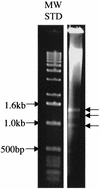Characterization of Porphyromonas gingivalis insertion sequence-like element ISPg5
- PMID: 10948151
- PMCID: PMC101785
- DOI: 10.1128/IAI.68.9.5247-5253.2000
Characterization of Porphyromonas gingivalis insertion sequence-like element ISPg5
Abstract
Porphyromonas gingivalis, a black-pigmented, gram-negative anaerobe, is found in periodontitis lesions, and its presence in subgingival plaque significantly increases the risk for periodontitis. In contrast to many bacterial pathogens, P. gingivalis strains display considerable variability, which is likely due to genetic exchange and intragenomic changes. To explore the latter possibility, we have studied the occurrence of insertion sequence (IS)-like elements in P. gingivalis W83 by utilizing a convenient and rapid method of capturing IS-like sequences and through analysis of the genome sequence of P. gingivalis strain W83. We adapted the method of Matsutani et al. (S. Matsutani, H. Ohtsubo, Y. Maeda, and E. Ohtsubo, J. Mol. Biol. 196:445-455, 1987) to isolate and clone rapidly annealing DNA sequences characteristic of repetitive regions within a genome. We show that in P. gingivalis strain W83, such sequences include (i) nucleotide sequence with homology to tRNA genes, (ii) a previously described IS element, and (iii) a novel IS-like element. Analysis of the P. gingivalis genome sequence for the distribution of the least used tetranucleotide, CTAG, identified regions in many of the initial 218 contigs which contained CTAG clusters. Examination of these CTAG clusters led to the discovery of 11 copies of the same novel IS-like element identified by the repeated sequence capture method of Matsutani et al. This new 1,512-bp IS-like element, designated ISPg5, has features of the IS3 family of IS elements. When a recombinant plasmid containing much of ISPg5 was used in Southern analysis of several P. gingivalis strains, including clinical isolates, diversity among strains was apparent. This suggests that ISPg5 and other IS elements may contribute to strain diversity and can be used for strain fingerprinting.
Figures




References
-
- Abeles A, Reaves L, Youngren-Grimes B, Austin S. Control of P1 plasmid replication by iterons. Mol Microbiol. 1995;18:903–912. - PubMed
-
- Ali R W, Martin L, Haffajee A D, Socransky S S. Detection of identical ribotypes of Porphyromonas gingivalis in patients residing in the United States, Sudan, Romania, and Norway. Oral Microbiol Immunol. 1997;12:106–111. - PubMed
-
- Chandler M, Fayet O. Translational frame shifting in the control of transposition in bacteria. Mol Microbiol. 1993;7:497–503. - PubMed
Publication types
MeSH terms
Substances
Grants and funding
LinkOut - more resources
Full Text Sources

